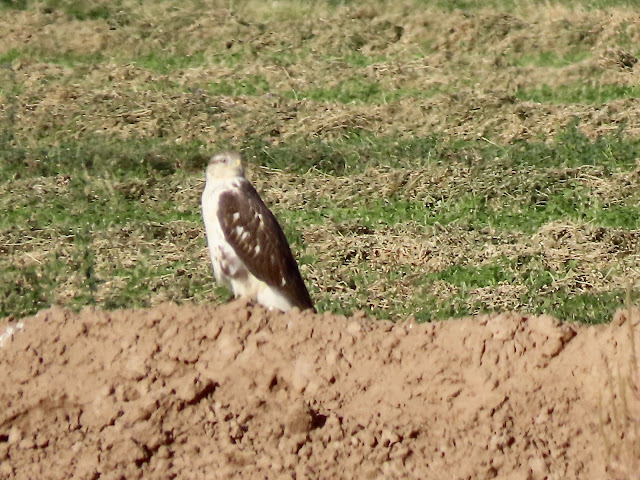November 17, 18, 19, 2021
DAY #1: Wednesday, November 17, 2021
1. CANOA RANCH CONSERVATION PARK, I-19 South of Continental Road, Green Valley.
Quite overcast when we arrived at Canoa Park, the pond was full of ducks hard to distinguish in the morning light. Most numerous duck on the pond was REDHEAD, normally one of my favorites. In poor light they seemed less exciting despite the fact Lois counted 48 of them!
A pair of NORTHERN PINTAIL, a flock of AMERICAN WIGEON and a single BUFFLEHEAD also enjoyed the pond.
Walking the trails around and beyond the pond, we spotted both a COOPER'S and a SHARP-SHINNED HAWK checking out the pond and grasses with fly-overs.
Both an adult and juvenile VERMILLION FLYCATCHER lighted up the drab atmosphere. Photo of the juvie male is below.
Early in my serious birding days, I had decided to learn the many different sparrow species. Well, I applied myself to that task when I was in places where they were plentiful but that is not everywhere. Slowly, however, I'm learning them in the field. Seeing seven sparrow species at this one site was really fun, but I photographed only one species, the BREWER'S SPARROW, below. They were all flitting from grass to bush to tree.
A small flock of LAWRENCE'S GOLDFINCH perched up in a bush near us. Photo below shows its yellow wing bars in contrast to the white of our usual Lesser Goldfinch. (Poor photo, sorry)
In the 1.5 hours we birded the Conservation Park, we managed to come up with 23 species.
Clicking the eBird link below, will reveal all the species we were able to spot in that time period.
View this checklist online at https://ebird.org/checklist/S97704654
Here, of course, there were more waterfowl on the pond, a Mourning Dove, Black and Say's Phoebe at the edges, and a Clay-colored Sparrow calling from the south end. As we returned to the car, we spotted a perched RED-TAILED HAWK.
3. Madera Canyon - PROCTOR ROAD
It proved slim pickings at this very quiet area this morning save for a couple ACORN WOODPECKER, a COMMON RAVEN and a YELLOW-RUMPED WARBLER.
Fascinated by a butterfly shown to us by a gentlemen taking photos of various ones, I managed to get a photo without changing my lens setting. Flabbergasted, really by its camouflage, it appeared to be a dead leaf. It was a MEXICAN FRITTILARY.
So impressed with this butterfly, later in the day I bought a laminated folder showing photographs of a good sampling of Arizona butterflies. Maybe I'll begin to recognize them when I'm in the field, too.
Also on Proctor Road were several Tarantula.
View this checklist online at https://ebird.org/checklist/S97845596
With Thanksgiving coming up next week, it was great to see so many WILD TURKEY foraging the grounds of the bird feeding area. The males were frequently displaying.
ACORN WOODPECKERs with their clown-like faces were moving about through the area from time to time.
Strangely, during the hot summer months, the GILA WOODPECKER began showing up at this higher elevation spot. After watching the ACORN WOODPECERs going to the feeders, the Gila apparently stopped hammering the nearby trees and flew in for some free goodies.
The perching framework for the LESSER GOLDFINCH has always delighted me, but it's rare to see it as full as it was today.
On up the road at Kubo Cabins feeders along the wash, we finally spotted a PAINTED REDSTART. Helping to find its dark eye in its dark head and face is a white arc below it.
We stopped by Santa Rita Lodge again later in the day. We found one of the MEXICAN JAYs taking a bath at the fountain.
A WHITE-BREASTED NUTHATCH was keeping its eye on us as it worked its way down a post.
View this checklist online at https://ebird.org/checklist/S97760750
View this checklist online at https://ebird.org/checklist/S97823625
Although we spotted 28 species, it was dark under the tall spreading trees and I took only one decent photo of the bird that likes to pose: VERMILLION FLYCATCHER, below.
View this checklist online at https://ebird.org/checklist/S97761940
What joyful birds - these LAZULI BUNTINGS, below:
Preparing to leave, this CEDAR WAXWING flew in to the pond area to check out the place.
View this checklist online at https://ebird.org/checklist/S97762086
View this checklist online at https://ebird.org/checklist/S97762253
DAY #3: Friday, November 19, 2021
LAS CIENEGAS NCA, (Sonoita).
Starting at a cool (41°F) dawn, sparrows were abundant in the grasslands. To catch sun rays, they perched up in bushes but sensed my camera lens. Simply stepping behind a thin limb with leaves was enough to protect them from me! But I got a few good ones, below. Order of appearance: VESPER, CHIPPING, WHITE-CROWNED and BAIRD'S.
As we approached by car at Cottonwood Tanks, sparrows hidden in trees few out in abundant flocks. We managed, however, to see a few of them, plus a NORTHERN HARRIER and GILA WOODPECKER.
In addition to an estimated 125 WHITE-CROWNED, there was one WHITE-THROATED SPARROW shown below:
Sensing that we had time to stop by Christopher Columbus Park in Tucson to see if we could find any of the recently reported birds, we spent a little over an hour there, walking both ponds.
View this checklist online at https://ebird.org/checklist/S97842934
View this checklist online at https://ebird.org/checklist/S97843879
View this checklist online at https://ebird.org/checklist/S97786505




















































